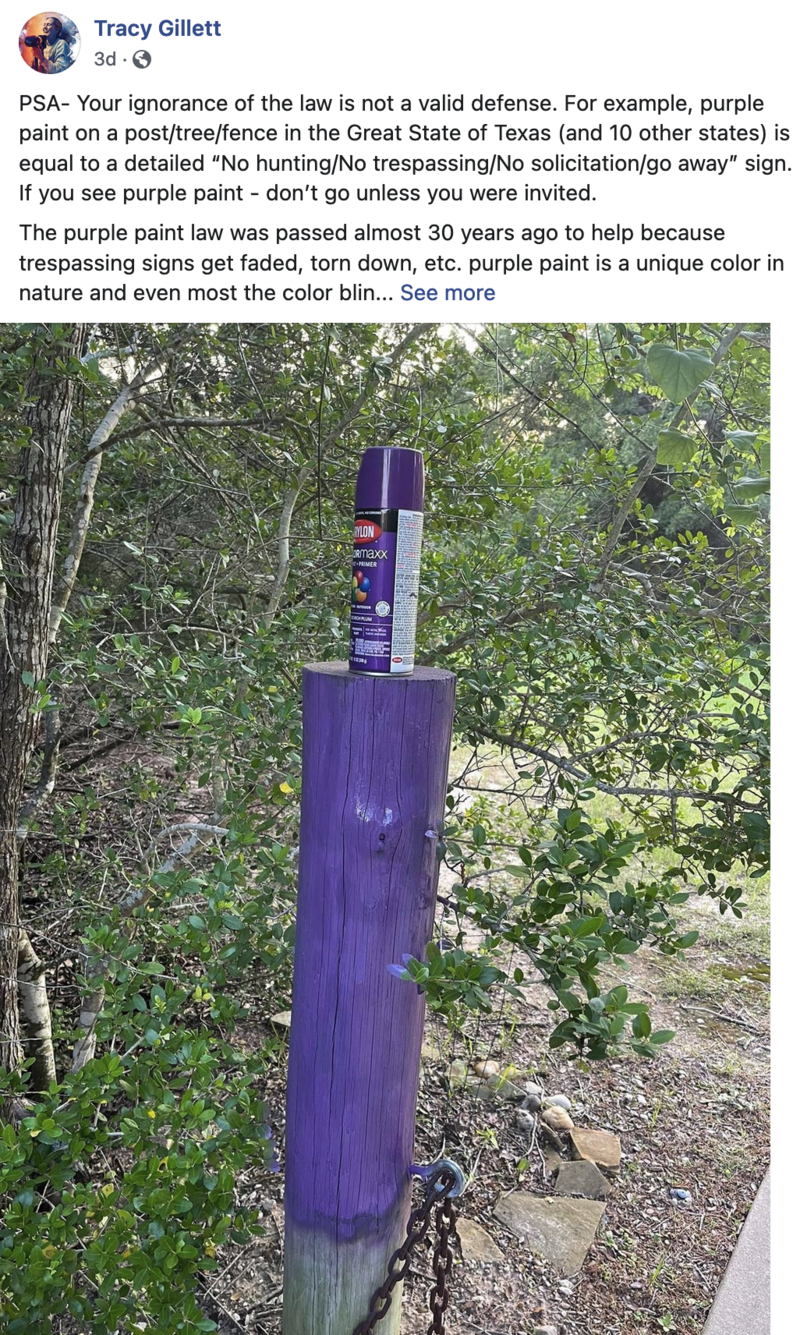
Does purple paint on a post, tree or fence in Texas and "10 other states" mean no hunting, no trespassing, no solicitation or, simply, go away? Yes, that's true: According to a U.S. government database, Texas and at least 11 other states have laws in which a specific shade of purple paint is equivalent to a written no-trespass or no-hunting sign. Such laws have been in place at least since 1989, with more states adopting it in recent years.
This claim appeared in a Facebook post on May 20, 2022, alongside an image of a purple spray paint can sitting atop a wooden post that has been mostly painted purple. The caption reads:
PSA- Your ignorance of the law is not a valid defense. For example, purple paint on a post/tree/fence in the Great State of Texas (and 10 other states) is equal to a detailed 'No hunting/No trespassing/No solicitation/go away' sign. If you see purple paint - don't go unless you were invited.
The purple paint law was passed almost 30 years ago to help because trespassing signs get faded, torn down, etc. purple paint is a unique color in nature and even most the color blind can see it.
This is what the post looked like on Facebook at the time of writing:
(Source: Facebook screenshot taken on Thu Jun 2 16:32:21 2022 UTC)
The post continues:
I've educated a couple people about the meaning because they weren't from around here and decided to stop by and try to swap howdys... but I have purple paint all up and down my posts on the driveway.
I found the most effective way to educate these individuals is by show and tell. I am showing you my shotgun and telling you to skedaddle. Don't be telling me your candidate is Pro 2nd amendment and hunting while you completely ignored the posts. No - I don't want to look at knives. No - I don't need my roof inspected for hail damage. No - I don't want to change my internet provider. No- Whatever you're selling, I'm not buying.
The more you know....
Inputting the keywords, "purple paint trespassing law" into the search function of usa.gov database produced numerous results that gave details about bills and laws in various states that have either been introduced or passed concerning purple paint as a no-trespassing marker.
One of these results included Texas Penal Code, section 30.05, where purple paint marks on a landowner's property can serve as a no-trespassing warning:
'Notice' means: an oral or written communication by the owner or someone with apparent authority to act for the owner; or fencing or other enclosure obviously designed to exclude intruders or to contain livestock; or a sign or signs posted on the property reasonably likely to come to the attention of intruders, indicating that entry is forbidden; or the placement of identifying purple paint marks on trees or posts on the property. If purple paint is used, then the purple paint must be vertical lines of not less than eight inches in length and not less than one inch in width; placed so that the bottom of the mark is not less than three feet from the ground or more than five feet from the ground; and placed at locations that are readily visible to any person approaching the property and no more than: 100 feet apart on forest land or 1,000 feet apart on land other than forest land.
In Texas, this no-trespassing statute was enacted on September 1, 1997.
Arkansas was the first to enact a "purple paint law" in 1989. Since then Florida, Illinois, Kansas, Louisiana, Maine, Missouri, Montana, North Carolina and Virginia have passed similar purple-paint laws -- with Pennsylvania being the most recent to enact the law in 2020.
Some states such as Idaho and Arizona have enacted similar laws where fluorescent orange is the color used instead of "no hunting purple."
















